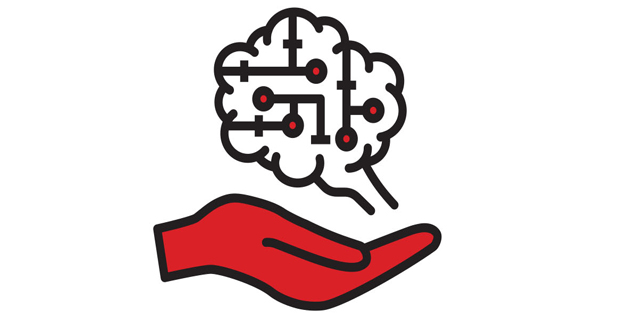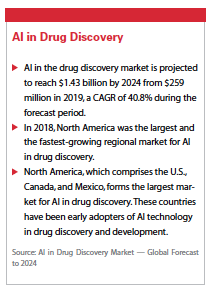Cyclica and ATAI Partner to Develop Drugs to Treat Mental Health
Trend Watch: Partnerships Leverage AI for Drug Discovery and Development
Cyclica, an artificial intelligence-powered biotechnology company, has partnered with the biotech company ATAI Life Sciences to create Entheogenix Biosciences.
 Entheogenix Biosciences is aimed at advancing psychedelic research for the development of better medicines for mental health diseases such as depression, bipolar disorder, and schizophrenia. Current therapies that rely on single-targeted drug interventions often fall short. Through AI, computational biophysics, and a data-driven pipeline, Entheogenix’s goal is to design and synthesize new compounds from psychoactive seed small-molecule compounds. Cyclica’s AI-augmented end-to-end drug discovery platforms, Ligand Design and Ligand Express, will be used to design advanced lead-like molecules with the preferred properties, while providing a holistic understanding of a molecule’s activity. This is said to allow researchers to visualize the complete profile of a compound and tailor drugs to target specific disease pathways related to mental health, while minimizing unwanted off-target effects.
Entheogenix Biosciences is aimed at advancing psychedelic research for the development of better medicines for mental health diseases such as depression, bipolar disorder, and schizophrenia. Current therapies that rely on single-targeted drug interventions often fall short. Through AI, computational biophysics, and a data-driven pipeline, Entheogenix’s goal is to design and synthesize new compounds from psychoactive seed small-molecule compounds. Cyclica’s AI-augmented end-to-end drug discovery platforms, Ligand Design and Ligand Express, will be used to design advanced lead-like molecules with the preferred properties, while providing a holistic understanding of a molecule’s activity. This is said to allow researchers to visualize the complete profile of a compound and tailor drugs to target specific disease pathways related to mental health, while minimizing unwanted off-target effects.
The companies expect the venture to lead to medications that offer the presumed benefits of the psychedelic for depression, and with enhanced properties such as faster drug release and absorption or the absence of the hallucinogenic effects common to psychedelics.
PathAI Teams up with Pharma for Drug Development and Diagnosis
Boston-based PathAI, a maker of artificial intelligence tools for pathology, gained Series B funding with a $15 million strategic investment from the Merck Global Health Innovation Fund and Bristol-Myers Squibb. This brings the startup’s full round of financing to $75 million, and its total funding to just more than $90 million.
PathAI’s technology assists pathologists in making rapid and accurate diagnoses for every patient, every time. PathAI is also building solutions to help identify patients that benefit from novel therapies, to make scalable personalized medicine a reality. Some of the world’s largest pharma giants are on its client list, such as Novartis, Gilead Sciences, and Bristol-Myers Squibb, the company reports. Merck and BMS are working with the company to develop new cancer therapies using PathAI’s technology.
Additionally, PathAI and Gilead have published the results of analyses examining the severity of nonalcoholic steatohepatitis (NASH) in liver biopsy samples from patients enrolled in the Phase III selonsertib studies (STELLAR). Strong correlations were demonstrated between AI-powered and manual pathologist interpretations of the histological features of NASH. The data support the potential utility of machine learning models in NASH clinical trials and highlight the benefits of generating automated and quantitative assessments for staging and characterizing this disease.
NIH Using AI to Evaluate Stem Cell Quality
NIH researchers used artificial intelligence to evaluate stem cell-derived “patches" of retinal pigment epithelium (RPE) tissue for implanting into the eyes of patients with age-related macular degeneration (AMD).
The study demonstrates the potential for AI to perform quality control of therapeutic cells and tissues. Researchers at the National Eye Institute, part of NIH, and the National Institute of Standards and Technology, worked together to develop the method. Cells of the RPE support the light-sensoring photoreceptors in the eye and are among the first to die from geographic atrophy, known as dry AMD. Without the RPE, photoreceptors die, leading to blindness and vision loss.
The team is working on a technique for making RPE replacement patches from AMD patients’ cells. Patient blood cells are coaxed in the lab to become induced pluripotent stem cells (IPSCs), which can become any type of cell in the body. The IPS cells are then seeded onto a biodegradable scaffold where they are induced to differentiate into mature RPE. The scaffold-RPE is implanted back into the eye behind the retina to preserve vision.
In an animal model, the patch successfully preserved vision, and the team is planning a clinical trial.
The AI algorithm leveraged deep neural networks and was trained on images of the RPE obtained using quantitative bright-field absorbance microscopy.
Researchers trained the networks to identify visual indications of RPE maturation that correlated with positive RPE function.
Specifically, the AI-based image analysis method accurately identified known markers of RPE maturity and function. The method can also match a particular iPSC-RPE tissue sample to other samples from the same donor, which helps confirm the identity of tissues during clinical-grade manufacturing.
Insilico and ChemDiv Partner on Cancer Drug Candidates
Insilico Medicine and ChemDiv are partnering to develop and market annotated compound libraries to advance the discovery of new oncology drug candidates.
Insilico Medicine’s pharmaceutical artificial intelligence platform, which is based on “omics" data analysis and deep learning methods, will add a valuable annotated component to ChemDiv’s anticancer library. ChemDiv’s proprietary chemistry, which is focused on small molecule drug development, will provide several thousand new oncology candidates. The initiative is expected to identify a mass of drug candidates in the early stages. By using AI, the company can scan a vast number of compounds at higher speeds and with improved accuracy compared with traditional screening.
“We have successfully identified early drug candidates by screening a limited number of compounds with our AI virtual screening platform," says Alex Zhavoronkov, Ph.D., founder and CEO, of Insilico Medicine. “ChemDiv increases our capabilities by opening a great lead-like and drug-like novel chemical space with reliable support."
Sergey Bugrov, executive director of ChemDiv said: “With Insilico Medicine’s AI technology, previously intractable targets could become viable therapeutic opportunities and the time for preclinical drug discovery could dramatically shorten. Our joint goal is to generate new leads against identified and predicted novel targets."
Machine Learning Microscope Improves Malaria Diagnosis
Engineers at Duke University have developed a new type of microscope that adapts its lighting angles, and colors while teaching itself the optimal settings needed to complete a given diagnostic task.
In the initial proof-of-concept study, the microscope developed a lighting pattern and classification system that allowed it to quickly detect red blood cells infected by the malaria parasite more accurately than trained physicians.
Researchers fed the microscope hundreds of samples of malaria-infected red blood cells. The microscope learned which features of the sample were most important for diagnosing malaria and how to best highlight those features.
“Computers can see things humans can’t," says Roarke Horstmeyer, assistant professor of biomedical engineering at Duke. “So not only have we redesigned the hardware to provide a diverse range of lighting options, we’ve allowed the microscope to optimize the illumination for itself."
The microscope was able to produce resulting images that highlight the malaria parasite in a bright spot and correctly classify malaria about 90% of the time. Trained physicians and other machine learning algorithms only correctly classify about 75% of the time.
After seeing the microscope’s initial success, the team sent the LED pattern and machine learning algorithm to a partnering lab, where it performed with a similar level of accuracy. The team expects their model to accelerate the time it takes physicians to identify and diagnose malaria in patients.
Geisinger and EarlySign Partners Earn Advance in CMS AI Challenge
CMS has selected Geisinger, an integrated health services organization, and EarlySign, a pioneer in developing machine learning techniques for early detection of disease, for its joint proposal in the agency’s Artificial Intelligence Health Outcomes Challenge. The partnering organizations are among 25 others advancing to stage 1 of the competition.
Launched in March 2019, the CMS AI Health Outcomes Challenge provides an opportunity for innovators to show how AI tools can predict unplanned hospital admissions and adverse events. This could lead to the use of more AI tools in CMS innovation center payment and service delivery models.
More than 300 organizations submitted AI innovations to the challenge.
Geisinger and EarlySign’s proposal, Reducing Adverse Events and Avoidable Hospital Readmissions by Empowering Clinicians and Patients, seeks to apply AI and machine learning algorithms to Medicare administrative claims data.
Researchers expect that this could result in the development of models that predict unplanned hospital and skilled nursing facility admissions within 30 days of discharge, as well as adverse events like respiratory failure, postoperative pulmonary embolism, deep vein thrombosis, or sepsis.
“About 4.3 million hospital readmissions occur each year in the U.S., costing more than $60 billion, with preventable adverse patient events creating additional clinical and financial burdens for both patients and healthcare systems," says David Vawdrey, Ph.D., chief data informatics officer at Geisinger.
CMS launched the AI Health Outcomes Challenge in partnership with the American Academy of Family Physicians and Arnold Ventures. The competition engages experts from all industries to leverage the power of AI to improve healthcare processes and patient outcomes.
The challenge takes place in three stages. CMS will announce the stage 2 finalists in April 2020, and final awardees and the grand prize winner in September 2020. CMS and its partners will award the grand prize winner up to $1 million; the runner-up will receive $230,000.
Insitro Earns Spot on Forbes’ AI 50 List, Partners with Gilead
Data-driven drug discovery and development company Insitro has earned a slot on Forbes’ inaugural AI 50 list; a list described as containing America’s most promising AI companies.
Insitro is the highest-capitalized healthcare startup on the list, which also included PathAI, Deep6, Viz.ai, and K Health. To be included on the list, companies needed to show that techniques like machine learning, natural language processing, or computer vision are a core part of their business model and future success.
Founder and CEO Daphne Koller says what sets Insitro apart from the other startups promising to use advanced computing tools to improve drug discovery is its ability to create the enormous data sets necessary to feed its software’s algorithmic appetites. It can create those data sets thanks to its massive financial support.
In other company news, Insitro entered into a partnership with drug maker Gilead Sciences to help it find a treatment for nonalcoholic steatohepatitis, or NASH. The company is applying state-of-the-art technologies from bioengineering to create massive data sets that enable the power of modern machine learning methods to be brought to bear on key bottlenecks in pharmaceutical R&D. The resulting predictive models will be used to accelerate target selection, to design and develop effective therapeutics, and to inform clinical strategy.(PV)
~~~~~~~~~~~~~~~~~~~~~~~~~
AI in Drug Discovery
 AI in the drug discovery market is projected to reach $1.43 billion by 2024 from $259 million in 2019, a CAGR of 40.8% during the forecast period.
AI in the drug discovery market is projected to reach $1.43 billion by 2024 from $259 million in 2019, a CAGR of 40.8% during the forecast period.
In 2018, North America was the largest and the fastest-growing regional market for AI in drug discovery.
North America, which comprises the U.S., Canada, and Mexico, forms the largest market for AI in drug discovery. These countries have been early adopters of AI technology in drug discovery and development.
Source: AI in Drug Discovery Market — Global Forecast to 2024



















